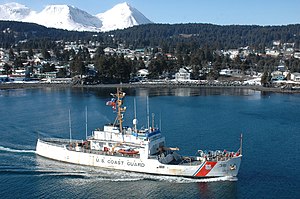World War II
The ship was laid down by the Toledo Shipbuilding Company of Toledo, Ohio, on 14 July 1941. Storis was launched on 4 April 1942 and commissioned on 30 September 1942 as an ice patrol tender. Initially assigned to the North Atlantic during World War II, Storis participated in the Greenland Patrols. [2] She was tasked with patrolling the east coast of Greenland to prevent the establishment of German weather stations. During her first years, Storis operated in the very waters from which her name was derived. Originally to be named Eskimo, the U.S. Department of State objected to the name of the new cutter on the basis that the natives of Greenland would be offended by the name. [4] "Storis" is a Scandinavian word meaning "great ice." [1]
On 10 June 1943, she began escorting convoy GS-24 from Narsarssuak to St. John's, Newfoundland, in company with the USCGC Mojave (flag), Tampa, Escanaba, and Algonquin, the convoy consisting of USAT Fairfax and USS Raritan. At 0510 on the 13th, dense black and yellow smoke was reported rising from the Escanaba. She sank at 0513. Storis and Raritan were ordered to investigate and rescue survivors while the rest of the convoy began zigzagging and steering evasive courses to avoid submarines. At 0715 the two cutters returned, having rescued 2 survivors and found the body of Lt. Robert H. Prause, which was on the Raritan. No explosion had been heard by the other escort vessels. The entire crew of 103 of the Escanaba was lost with the exception of these two men.
Post World War II career
Following the war, the homeport of Storis was changed from Boston to Curtis Bay, Maryland. On 15 September 1948, Storis was reassigned to Juneau, Alaska where she participated in the Bering Sea Patrol, which entailed delivering medical, dental and judicial services to isolated native villages in the far reaches of the territory. At the same time, Storis assisted in establishing Alaskan LORAN radio-navigation stations, provided supplies for the Distant Early Warning Line and conducted hydrographic surveys in the uncharted waters off the Arctic.
On 1 July 1957, Storis departed in company with the Coast Guard Cutters Bramble and Spar to search for a deep draft channel through the Arctic Ocean and to collect hydrographic information. Shortly after her return in late 1957, the Storis was reassigned to her new homeport of Kodiak, Alaska.
In 1972, Storis underwent a major renovation converting her from a light icebreaker to a medium endurance cutter. With the change in designation, there also came a change in primary duties. The primary functions of Storis shifted to enforcing laws and treaties of the domestic and foreign fisheries in the Bering Sea and Gulf of Alaska. Storis underwent another major maintenance overhaul in 1986 that replaced her power plant and expanded her living quarters to include a new berthing area for women and a lounge for the crew.
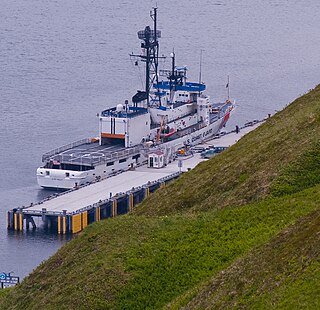
USCGC Alex Haley (WMEC-39) is a United States Coast Guard Cutter and former United States Navy vessel that was recommissioned for Coast Guard duty on 10 July 1999. It first entered service as USS Edenton (ATS-1), an Edenton-class salvage and rescue ship on 23 January 1971. In 1995, Edenton won the Marjorie Sterrett Battleship Fund Award for the Atlantic Fleet.

USCGC Acushnet (WMEC-167) was a cutter of the United States Coast Guard, homeported in Ketchikan, Alaska. She was originally USS Shackle (ARS-9), a Diver-class rescue and salvage ship commissioned by the United States Navy for service in World War II. She was responsible for coming to the aid of stricken vessels and received three battle stars during World War II, before a long career with the Coast Guard. Acushnet patrolled the waters of the North Pacific and was one of the last World War II era ships on active duty in the US fleet upon her retirement in 2011.
The Medium Endurance Cutter or WMEC is a type of United States Coast Guard Cutter mainly consisting of the 270-foot (82 m) Famous- and 210-foot (64 m) Reliance-class cutters. These larger cutters are under control of Area Commands. These cutters have adequate accommodations for crew to live on board and can do 6 to 8 week patrols.

The USCGC Escanaba (WPG-77) was a 165 ft (50 m) "A" type United States Coast Guard cutter stationed on the Great Lakes from her commissioning in 1932 until the start of U.S. military involvement in World War II in 1941. With the outbreak of war, Escanaba redeployed to participate in the Battle of the Atlantic, during the course of which she was ultimately lost with nearly all hands. Struck by either a torpedo or mine in the early morning of 13 June 1943, while serving as a convoy escort, Escanaba suffered a fiery explosion and sank within minutes, leaving only two survivors and one body out of her 105-man crew to be found on the surface by rescuers.

USCGC Jarvis (WHEC-725) was a Hamilton-class cutter of the United States Coast Guard. She was launched on 24 April 1971 and commissioned on 4 August 1971 homeported at Honolulu, Hawaii; served on Ocean Station November and fisheries patrols and search and rescue missions in the Bering Sea. She received a FRAM upgrade in 1990–2. Jarvis was decommissioned on 2 October 2012 and in January 2013 the Coast Guard announced that she would be transferred to the Bangladesh Navy late that year. She was commissioned as BNS Somudra Joy (F-28) on 23 December 2013.

USCGC Forward (WMEC-911) is a United States Coast Guard medium endurance cutter. She is the fourth cutter of that name; two were United States Revenue Cutter Service vessels and two, including the contemporary cutter, Coast Guard vessels. All were named for Walter Forward, fifteenth United States Secretary of the Treasury. The present Forward was constructed by Robert Derecktor Shipyard Incorporated, Middletown, Rhode Island, was delivered in May 1989, and commissioned 4 August 1990. USCGC Forward (WMEC-911) and USCGC Legare (WMEC-912) were commissioned in a joint ceremony in Portsmouth, Virginia.

USCGC Escanaba (WMEC-907) is a United States Coast Guard medium endurance cutter based in Portsmouth, Virginia. Her keel was laid on April 1, 1983, at Robert Derecktor Shipyard Incorporated, Middletown, Rhode Island. She was launched February 6, 1985 and is named for her predecessor, USCGC Escanaba (WPG-77) which sank during World War Two, and was named for the Escanaba River and Escanaba, Michigan. Escanaba (WMEC-907) was formally commissioned August 29, 1987 in Grand Haven, Michigan, the home port of her predecessor.

USCGC Confidence (WMEC-619) is a United States Coast Guard medium endurance cutter.

USCGC Dependable (WMEC–626) is a United States Coast Guard medium endurance cutter. Dependable was commissioned November 22, 1968. On April 9, 2024 Dependable was removed from active duty and placed in commission, special status. Her most recent homeport was Virginia Beach, Virginia.

USS Seize (ARS-26) was a Diver-class rescue and salvage ship commissioned in the United States Navy during World War II. Her task was to come to the aid of stricken vessels.

USCGC Escanaba (WHEC-64) was an Owasco-class high endurance cutter built for World War II service with the United States Coast Guard. The war ended before the ship was completed and consequently she never saw wartime service.

USCGC Klamath (WHEC-66) was an Owasco-class high endurance cutter built for World War II service with the United States Coast Guard. The war ended before the ship was completed and consequently Klamath did not see wartime service until the Vietnam War.
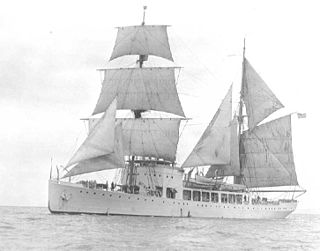
USCGC Northland (WPG-49) was a United States Coast Guard cruising class of gunboat especially designed for Arctic operations in commission from 1927 to 1938 and from 1939 to 1946. She served during World War II. She was the last cruising cutter built for the Coast Guard equipped with a sailing rig.
USCGC Raritan (WYT-93/WYTM-93) was a United States Coast Guard 110 ft (34 m) harbor tug that was in service from 1939 to 1988. She served on the Greenland Patrol during World War II and after the war on the Great Lakes. From 1980 until decommissioning she was homeported at Governors Island.
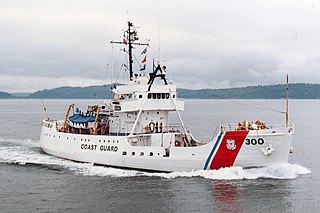
USCGC Citrus (WAGL-300/WLB-300/WMEC-300) was a Cactus (A)-class seagoing buoy tender built in 1942 in Duluth, Minnesota, and now operated by the navy of the Dominican Republic.
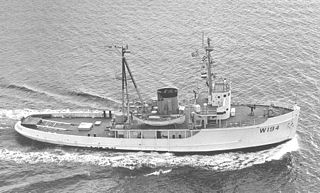
The auxiliary ocean tug USS ATA-194 was laid down on 7 November 1944 at Orange, Texas, by the Levingston Ship Building Co.; launched 4 December 1944; and commissioned at Orange on 14 February 1945.
USCGC Clover WAGL/WLB/WMEC-292, a Cactus (A) Class buoy tender was built by Marine Iron and Shipbuilding, Duluth, Minnesota. Her keel was laid 3 December 1941, and she was launched 25 April 1942. She was commissioned on 8 November 1942 in the United States Coast Guard as the United States Coast Guard Cutter Clover. She was built as a WAGL, redesignated a WLB in 1965, and again redesignated a WMEC in 1979.
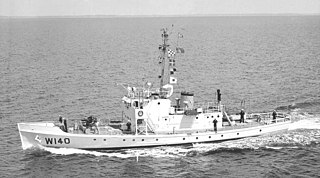
USCGC General Greene (WPC/WSC/WMEC-140), was a 125 ft (38 m) United States Coast Guard Active-class patrol boat, in commission from 1927 to 1968 and the fourth cutter to bear the name of the famous Revolutionary War general, Nathanael Greene. She served during the Rum Patrol, World War II and into the 1960s performing defense, law enforcement, ice patrol, and search and rescue missions.

USCGC Morris (WSC-147), was a 125 ft (38 m) United States Coast Guard Active-class patrol boat in commission from 1927 to 1971. She was named for Robert Morris, (1734–1806) who was appointed in 1789 as United States Senator from Pennsylvania. In May 1966, she was redesignated as (WMEC-147).

USCGC McLane (WSC-146) is a 125 ft (38 m) United States Coast Guard Active-class patrol boat in commission from 1927 to 1971. She was named for Louis McLane, (1786–1857) who was appointed in 1833 as United States Secretary of State. In May 1966, she was redesignated as (WMEC-146).
